For those intrigued by the charm of jewels, and especially for aficionados of unique gems, black diamonds beckon with a rare allure. Black may often be referred to the color of witchcraft or the black hole or the outer space, but this symbolic color for darkness is, in the context of diamond, more of a color luxury and style.
These beguiling gems, sometimes referred cob as fancy colored diamonds, stun onlookers with their natural black color.
BrighterGuide aims to delve deep into the features, aesthetic appeal, and lore surrounding black diamonds. Furthermore, we’ll unravel the story behind carbonados, a resilient variety of black diamond.
So, accompany us on a journey that uncovers the mystique of black diamonds.
Related article: The Fascinating World of Blue Diamonds
Key Takeaways
- Black diamonds are unique and rare gems that symbolize luxury, style, and darkness, with a natural allure rooted in their inherent black or charcoal pigments.
- The deep hue of black diamonds is attributed to tiny inclusions and fractures within the stone, absorbing artificial light, giving them an enigmatic appearance; and treatments can further enhance this color.
- Historically, the color black was associated with strength, humility, and honor, but it became more coveted in the 20th Century, marking black diamonds as symbols of opulence, heritage, and cosmic wonder.
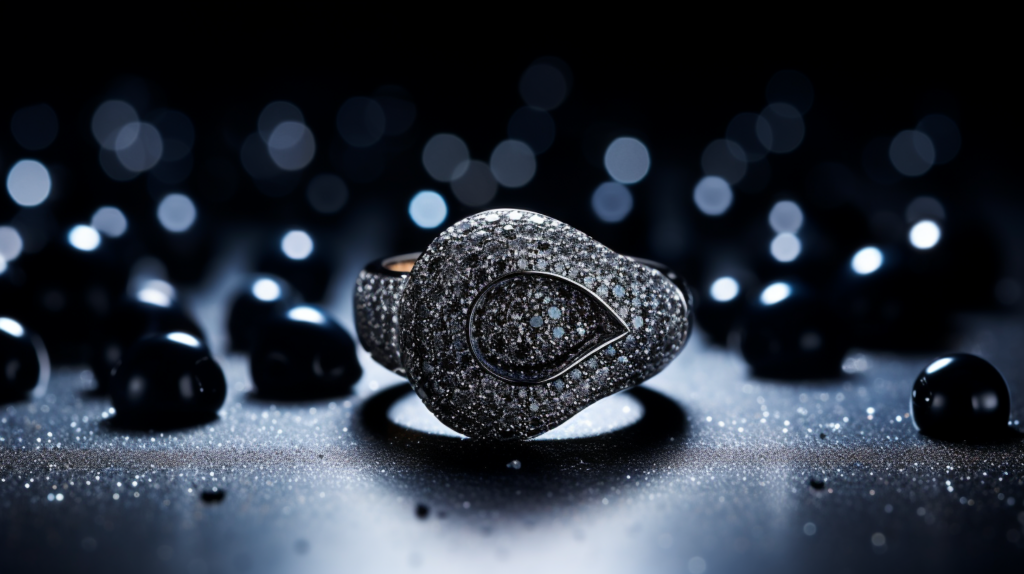
In this post, we’ll explore:
An Ultimate Guide to Black Diamonds
What sets black diamonds apart from their clearer counterparts?
Termed as fancy colored diamonds, black diamonds boast of peculiar traits distinguishing them from the usual colorless variety or those with bright colors. At the heart of their intrigue is their inherent black color or somewhat charcoal pigments. This color originates from minute, shadowy inclusions and fractures within the diamond, endowing it with an aura of enigma. A majority of black diamonds possess an opaque countenance, shimmering with a metallic luster, though a few present a translucent salt-and-pepper visage. Moreover, the hues of black diamonds can sometimes tilt towards dark brown or green.
The blackness, outer space like color of such diamonds from from large quantities or small, minute mineral inclusions—yes, like charcoal pigments or charcoal powder—such as graphite, pyrite or hematite that extend throughout the stone. Hence, they block off artificial light or incoming like, thus bright colors are absent and the appearance of space, albeit dark, is perceived.
The chemical composition and the atomic architecture of the crystal govern the color. Interestingly, while they might not be as pricy as white diamonds due to market dynamics, their unusual shade and relative rarity are cherished by connoisseurs and collectors.
While diamonds in general symbolizes strong emotional connection, the traditional color of black in diamonds, in contrast to bright colors, symbolizes justice and inner strength in particular. Black, in diamonds, is not the traditional color of witchcraft but a color of humility a color of cavalry
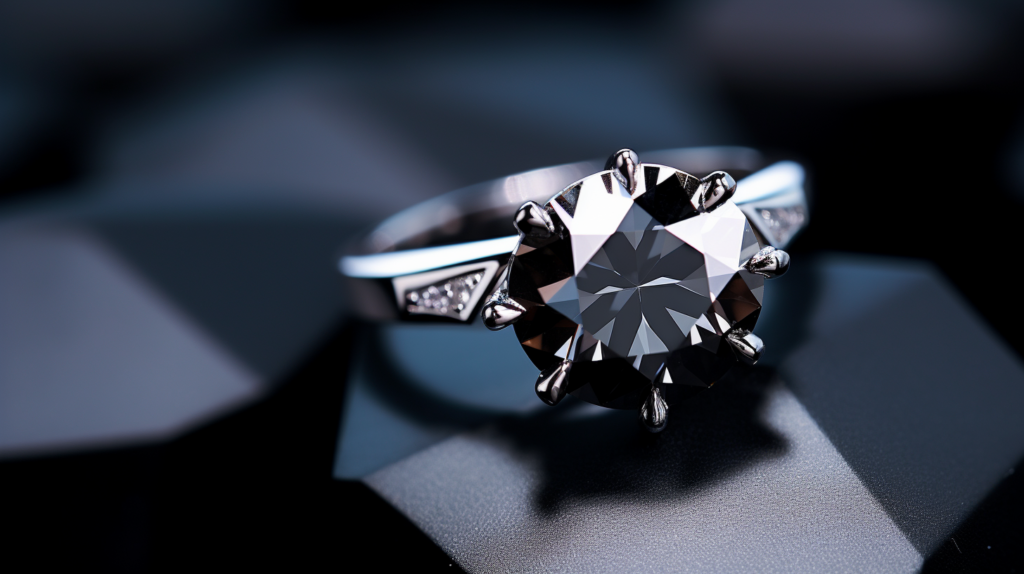
What are Black Diamonds?
Fancy black diamonds are colored diamonds assessed differently than their colorless counterparts. Their color can be innate or enhanced through treatments.
Despite their mesmerizing hue, the market demand often dictates that this diamonds of charcoal pigments or charcoal powder cost less than those with the traditional color—white. The allure of the color black in gemstones, particularly in diamonds, has long fascinated both collectors and casual admirers alike. One might wonder why this hue, often associated with mystery and elegance, became so integral in the world of jewels.
To understand this, we journey back to the 20th Century. In this era, the color in art began to evolve and expand in intriguing ways. Artists and jewelers alike were experimenting, trying to encapsulate the emotions and grandeur of the times. The traditional color palette was frequently sidelined for bolder, more expressive shades. Among them, the unique and mesmerizing black diamonds stood out, making their mark in the annals of jewelry history.
Contrary to what one might believe, the color black was not always as coveted as in the 20th Century. Before this, it was predominantly associated with the color of cavalry, symbolizing strength, resilience, and honor. It was also recognized as the color of humility, revered in certain cultures for its depth and solemnity.
In the realm of gemstones, the black diamond’s enchanting hue set it apart. Unlike the bright colors that often define gems, color black diamonds exuded an air of mystery and allure, catching the eye and captivating the soul. Historically, black diamonds were also linked with the color of witchcraft, giving them a unique, almost mystical reputation.
Their widespread use in jewelry was further propelled by the innovations of the 20th Century. The color of printing began using shades of black more frequently, making it a common color in visual media. This increased familiarity with black paved the way for its acceptance and desire in various art forms, including jewelry.
Now, how does the color black appear so profound in these diamonds? The play of light has a lot to do with it. The artificial light can sometimes enhance the depth of the color, but it’s the incoming light and its interaction with the diamond that creates the profound effect. Black diamonds absorb a significant amount of this light. Instead of refracting it out like colorless diamonds, color black diamonds create an appearance of space, deepening their allure.
However, it’s not just light that contributes to their appearance. Techniques involving charcoal powder are sometimes used to enhance or treat these diamonds, giving them a more uniform color.
Evaluating Quality
Quality assessment revolves around specific criteria determining a black diamond’s value.
Black diamond jewelry, celebrated for its alluring look, isn’t uniform. Quality rests on color, clarity, cut, and size. While the shade can stretch from profound black to a salt-and-pepper look, clarity highlights the inclusions or imperfections. A superior clarity grade points towards a purer gem.
The diamond’s cut is responsible for its shine and twinkle, whereas its size is ascertained by its carat weight. The diamond’s origins, especially if they whisper tales of outer space, can also play into its evaluation.
Origins and Outer Space
One of the most fascinating aspects of black diamonds is their rumored connection with outer space. Some theories suggest that black diamonds come from the vast expanse of space, adding a layer of mystique to their allure. The very idea of wearing a piece of outer space, a cosmic relic, is an enticing proposition for many jewelry enthusiasts. These diamonds offer an appearance of space unlike any other, with the depths of their color reminiscent of the vastness and beauty of the cosmos.
The unique characteristic of black diamonds is their deep, almost endless hue, resembling the darkest recesses of space. This connection between black diamonds and outer space is not merely an aesthetic parallel. According to a study by Princeton University Press, certain characteristics of black diamonds suggest they may have been formed by an asteroid impact on Earth about 2.3 billion years ago. The ramifications of this discovery are profound, positioning black diamonds as remnants of a cataclysmic event that shook our planet.
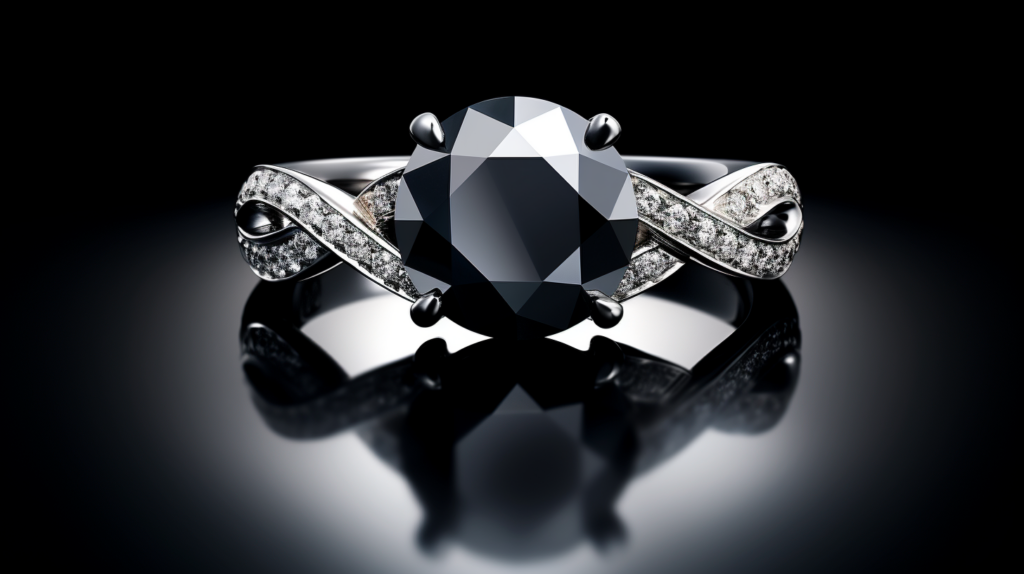
Now, let’s pivot our focus from the vast cosmos and dive deep into Earth’s cradle, to regions like North Africa and South Africa. These regions have, in their soils and mines, given birth to many a black diamond. However, it’s essential to differentiate these from their clear counterparts often sourced from West Africa. The black diamonds from North and South Africa have unique inclusions, making them distinct in the world of gems.
Traditional Color and Its Significance
Black is a traditional color in many cultures and often symbolizes power, elegance, and mystery. In the realm of gemstones, the traditional color of black diamonds sets them apart from their sparkling clear counterparts. While some might associate the color of cavalry with bravery and strength, others may see it as a symbolic color representing depth and intensity. This makes black diamonds an excellent choice for those wanting a piece of jewelry that tells a deeper story.
While diamonds, in general, are often seen as material possessions symbolizing luxury and prestige, black diamonds, given their rarity, occupy an even more elevated status. But their allure isn’t limited to their market value. In certain communities, especially those with a rich black ancestry, these diamonds are emblematic of strength, resilience, and pride.
Interestingly, a study from Cambridge University Press highlights that in some cultures in North Africa, black diamonds are considered as carriers of black blood – a symbol of rich heritage and profound depth of character. This belief, rooted in centuries-old traditions, adds another layer of significance to these already mesmerizing stones.
Symbolic Interpretations of Black
Diving deeper into color symbolism, black can represent a range of emotions and values. Historically, black was seen as the color of humility, often worn by those in positions of servitude or religious orders. On the other hand, in certain cultures, black is seen as the color of witchcraft and mystery, denoting power and a connection to the unknown. These varying symbolic interpretations make black diamonds versatile and deeply meaningful.
Influence of Light
Black diamonds have a unique way of interacting with light. Unlike clear diamonds which refract incoming light, producing a spectrum of colors, black diamonds absorb artificial light and reflect it in a muted manner. This means their sparkle is subtler but no less captivating. The presence of charcoal pigments and charcoal powder within the diamond can influence its interaction with light, giving each stone its distinctive glow.
A Common Color with Uncommon Beauty
While black might be seen as a common color in everyday life, in the world of gemstones, it’s anything but. Black diamonds stand out because of their rarity and the contrast they offer, especially when set in jewelry. Whether influenced by the color of printing or the deeper shades found in nature, their beauty is undeniable.
Historically, the black diamond was not always as sought after as it is today. Early records from Oxford University Press indicate that they were often overlooked in favor of their clearer counterparts. But with time, as our understanding deepened and cultural perspectives evolved, so did our appreciation for these dark gems.
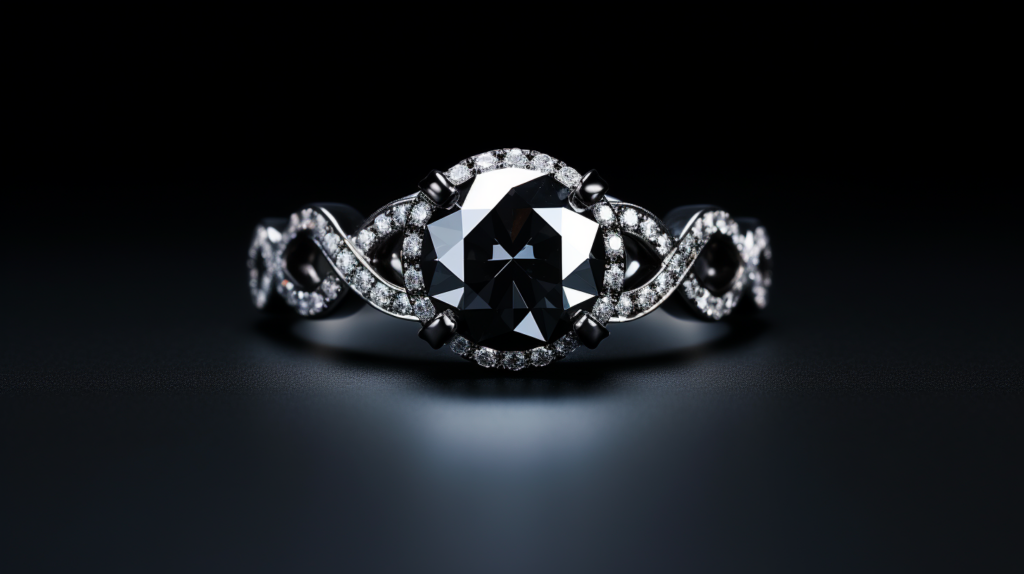
Fast forward to today, when black diamonds are not just celebrated for their “outer space” allure but also revered for their unique place in history and culture. Drawing insights from TheWayback Machine, it’s evident that the global perception of black diamonds has undergone a radical transformation over the decades.
A curious note from TheWayback Machine” details a moment when a black diamond was termed the “darkest material” at a prestigious gem exhibition. It outshone (or rather, out-darkened) all other materials, firmly placing itself as a symbol of opulence, heritage, and cosmic wonder.
Understanding these nuances allows us to delve into black diamond categorization.
Classification
It’s essential to comprehend how black diamonds are classified. Dubbed as fancy colored diamonds, they differ from the regular white gems. Their uniqueness lies in their black color, attributed to the inclusions and fractures within. While primarily opaque with a metallic shine, some showcase the salt-and-pepper look. The symbolic color of these diamonds, which signifies depth and wisdom, only amplifies their appeal among gem enthusiasts.
The beauty and enigma of black diamonds aren’t just bound by their lustrous appeal. Their depth is deeply tied to the symbolic color these gems represent. Black, in various cultures and beliefs, stands as a color resonating with mystery, sophistication, and elegance. It’s a hue that commands attention, demands respect, and evokes a myriad of emotions. Whether draped in a luxurious evening gown or adorning the finger as an engagement ring, the symbolic color of black is undeniable.
On the spectrum of traditional color, black stands out uniquely. Unlike other diamonds that aim for clarity and minimal inclusions, the black diamond’s beauty springs from its inclusions, giving it its distinctive shade. It’s a departure from the norm, a gem that doesn’t conform to the usual expectations of diamonds.
However, if one ventures into the realm of the color of cavalry, black holds its ground with pride and honor. Often seen as a robust and formidable hue, it’s a color often associated with strength and determination. Just like the resilient cavalry units of yore, the black diamond, too, symbolizes a tenacity that’s hard to come by.
With such potency, it’s surprising that black also represents the color of Humility. In many cultures, black signifies modesty, simplicity, and humility. It reminds us that beauty doesn’t always have to shout; sometimes, it can whisper and still be heard.
Furthermore, for those in the print world, black is recognized as the color of printing. This essential hue ensures that words come alive on paper, capturing thoughts, dreams, and visions for all to see. Its universality is unparalleled.
The black diamond, with its varying shades, from deep blacks to salt-and-pepper appearances, can be likened to charcoal pigments. Charcoal, known for its versatility in the art world, offers shades ranging from the darkest blacks to smudged grays. The resemblance is uncanny.
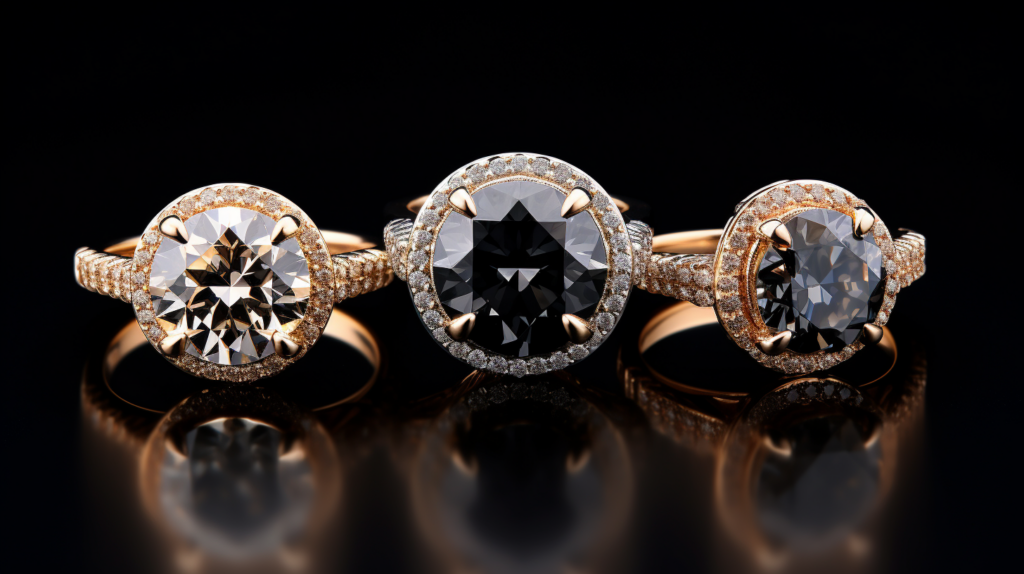
In the vast universe of colors, black is a common color. Yet, in the realm of diamonds, it’s anything but ordinary. The appeal lies in its rarity and the depth it brings, akin to the infinite appearance of space. It isn’t just a color; it’s an experience.
When viewed under artificial light, the black diamond reflects light differently than its transparent counterparts. It doesn’t sparkle in the traditional sense. Instead, it absorbs the incoming light, giving it a sheen that’s unparalleled in the gem world. This absorption and reflection of light is what makes the black diamond so enigmatic.
Pricing Dynamics
Several factors dictate the cost of a black diamond, but four pivotal considerations are:
- Uniqueness: Their relative rarity compared to white diamonds can elevate their price.
- Dimension: Larger black diamonds usually come with a steeper price tag.
- Excellence: Attributes like clarity, cut, and size directly influence a diamond’s value.
- Hue Depth: The depth and uniformity of the black pigment can sway the price, with richer shades being more coveted.
How These Diamonds Become Black
Grasping how these diamonds attain their blackness sheds light on their unique allure. These gems owe their color to tiny inclusions and fractures that act akin to miniature black holes, soaking up light and yielding the black shade.
Furthermore, black diamonds can undergo treatments using charcoal pigments, augmenting their color uniformly. The treatment uses high temperatures to embed the pigment.
Whether naturally occurring or treated, the enthralling charm of black diamonds, accentuated by their profound hue, makes them an unparalleled choice for statement jewelry.
The mystique surrounding black diamonds is as profound as their color. Delving into how these gems get their distinctive hue can provide clarity on what makes them so captivating. Here’s the story behind the dark allure of black diamonds.
Origins of the Black Shade
Imagine looking into the abyss of space, dotted with stars but largely dark and infinite. Black diamonds have a similar quality. Their depth doesn’t come from pigmentation, like other colored diamonds, but from countless tiny inclusions and fractures within the stone. These inclusions function somewhat like black holes, absorbing artificial light rather than reflecting it, bestowing upon the diamond its enigmatic black shade.
Treatments for Enhancing Color
While nature does create black diamonds, humans have found ways to enhance and perfect the color. One such method involves using charcoal pigments. This treatment exposes diamonds to high temperatures, allowing the charcoal pigment to integrate seamlessly, giving the diamond a consistent, deep black hue.
Natural or Treated, Still a Sight to Behold
The ultimate allure of black diamonds isn’t just about their color; it’s about the emotion they evoke. The profound depth of their hue, whether natural or achieved through treatment, has made black diamonds a popular and bold choice for jewelry that stands out.
Not all black diamonds are naturally occurring, though. Modern advancements have made it possible to treat colorless diamonds, turning them into the enigmatic black beauties. This treatment involves subjecting diamonds to high temperatures in a controlled environment. The process changes the diamond’s structure, ensuring it absorbs incoming light, which in turn gives it the black appearance.
But is there a difference between naturally occurring and treated black diamonds? From an aesthetic standpoint, both are virtually indistinguishable to the naked eye. However, gem enthusiasts might hold a special reverence for the naturally occurring variety due to their rarity and authenticity.
Deciphering the Color Codes
In your list, it appears you’ve mentioned color codes, which might correspond to some grading or referencing system. Here’s a more human-like interpretation:
Traditional Color: Likely a deep hue, close to pure, but not quite there. It reminds me of the almost-black of a traditional ink pot.
Color Of Cavalry: A shade closely linked with cavalry uniforms, perhaps a deep blue or green depending on the specific historical reference.
Color Of Printing: Possibly referring to the primary colors used in printing; cyan, magenta, yellow, and black.
Artificial Light: This artificial light could represent the warmth or coolness of artificial lighting, such as the yellow hue from tungsten bulbs versus the bluish tint from LEDs.
Incoming Light: Possibly the natural daylight spectrum, from warm sunrise to cooler midday light.
Charcoal Pigments: A near-pure pigment, resembling the deep, matte finish of charcoal.
Remember, colors, artificial light, and even incoming light are not just visual elements; they are experiences, carrying with them a flood of emotions, memories, and connotations. And black diamonds, with their mystique and allure, are an embodiment of that phenomenon.
Types of Black Diamonds
Two primary types dominate:
- Carbonado: Found mainly in Brazil and Central Africa, these natural diamonds are recognized by their black pigment or grayish hue, somewhat resembling charcoal. Carbonados are renowned for their toughness, ideal for industrial utilities like crafting cutting tools.
- Fancy Black Diamond Jewelry: These can be either naturally occurring or treated to attain a darker hue. Their shades span from deep black to lighter hues, tinged with gray or brown. These diamonds, with their sophisticated aura, are perfect for crafting jewelry pieces that stand out.
Types of Black Diamond Engagement Ring Settings
Black diamonds, with their profound hue, exude elegance and mystery. Symbolizing strength and power, they contrast starkly with traditional white diamond engagement rings. They’ve become a popular pick for those desiring an unconventional token of love.
Several setting styles accommodate Black Diamond Jewelry, each offering distinct aesthetics catering to diverse tastes.
Conclusion
In retrospect, black diamonds epitomize a rare blend of elegance and symbolism, and this does not change even in the 20th century up until now. Here’s a summary of our exploration:
- Elegance Personified: With an aura akin to a celestial night, they stand apart in the gem world.
- Meaningful Symbolism: They resonate with themes of resilience and power, absorbing negative vibes and ensuring protection.
- Adaptable Charm: Suitable for both casual and formal settings, they are versatile gems.
Visual Allure: Their unique interaction with light, combined with a metallic sheen, adds depth to any jewelry piece.
Sources
BrighterGuide is dedicated to providing accurate and relevant information as you explore the wonderful world of diamonds and jewelry. To this end, our writers refer to primary information sources in building each article that appears on this website. These include, but are not limited to, published news articles, government portals, research papers, and more.
- Homepage. (n.d.). Princeton University Press. https://press.princeton.edu/
- Home. (2023, September 29). Cambridge University Press & Assessment. https://www.cambridge.org/
- Human verification. (n.d.). https://global.oup.com/academic/
- Internet Archive: Wayback Machine. (n.d.). https://archive.org/web/